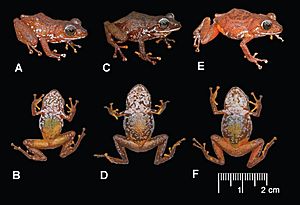Pristimantis jamescameroni facts for kids
Quick facts for kids Pristimantis jamescameroni |
|
|---|---|
 |
|
| Juvenile | |
| Scientific classification |
Pristimantis jamescameroni is a small frog from the Strabomantidae family. It has an orange-brown color. This frog has only been found in one place so far. That place is the Aprada-tepui, a flat-topped mountain in Bolívar state, Venezuela.
Scientists discovered this frog in June 2012. A Belgian biologist, Philippe J. R. Kok, officially described it in October 2013. He works at the Royal Belgian Institute of Natural Sciences. The frog was named after James Cameron, a famous Hollywood filmmaker. This was to honor his work in protecting the environment. It also recognized his support for veganism to help save animals. Because it lives in such a small area, this frog might be "endangered". This is according to the IUCN Red List of Threatened Species.
Contents
Discovery and Naming the Frog
Philippe Kok collected four Pristimantis jamescameroni frogs on June 15, 2012. He found them on the top of Aprada-tepui. One was an adult male, called the holotype. The other three were females, called paratypes.
The area where they were found is called the Pantepui region. It is in the northwestern part of the Guiana Shield. This region is special because many new species are found there. It is a key place for speciation, which is how new species form. Many unique animals, like birds, amphibians, and reptiles, live only there.
This region is already home to at least twenty other Pristimantis frog species. Some recently found ones include P. aureoventris and P. muchimuk.
The frog's name, jamescameroni, honors the film director James Cameron. He has won many awards for his movies. Cameron was chosen because he helps people learn about environmental problems. He does this through his popular movies and adventure documentaries. He also encourages people to try a vegan lifestyle. This is seen as a good way to reduce human impact on the environment. Things like global climate change are a big threat to places like the tepuis.
What the Pristimantis jamescameroni Looks Like
Pristimantis jamescameroni is a very small frog. It is mostly brown with orange stripes. Female frogs are a bit bigger than males. Females are about 2.6–2.7 cm or 1.0–1.1 in long from snout to vent. Males are smaller, about 2.3 cm or 0.9 in long.
Males have special rough pads on their thumbs called nuptial pads. Females do not have these. The hands and feet of males are also a little longer than those of females. The frog's back has many small white spots. Its arms and legs are similar in color, but with less orange. They have a few small white spots on the upper arms.
The underside of the frog's body is lighter and mostly orange. The tips of its toes are whitish. The head is a bit longer than it is wide. It is also wider than the main part of the body. The nostrils stick out slightly to the side. The eyes have an iris that can be silver, greenish-silver, or bronze. It has dark brown lines. This frog does not have a visible eardrum, called a tympanum.
The tongue is shaped like a heart. It is slightly longer than wide and rounded at the back. The back half of the tongue is free. Unlike some related frogs, this species does not have vocal slits or a vocal sac. This means they do not make loud calling sounds.
The fingers have wide, oval-shaped discs at the tips. These discs are wider than they are long. The legs are of medium length. The toes also have discs that are similar in size and shape to the finger discs.
Where the Frog Lives and Its Environment
Pristimantis jamescameroni has only been found on the top of Aprada-tepui. This is in Bolívar state, Venezuela. It lives at a high elevation, between 2,557 and 2,571 m (8,389 and 8,435 ft) above sea level.
The area is mostly open rocky land with small patches of tepui forests. This region has many small lakes and deep canyons. The frogs mainly live underneath shallow rocks. The first male frog found was calling from a small rock crack. It was hidden by plants. All other frogs were found hiding under rocks. Other males were heard calling quietly from rock cracks during the day.
Because these frogs live in such a small area, scientists believe they are endangered. This means they are at high risk of disappearing.
See also
 In Spanish: Pristimantis jamescameroni para niños
In Spanish: Pristimantis jamescameroni para niños
- List of organisms named after famous people (born 1950–present)


